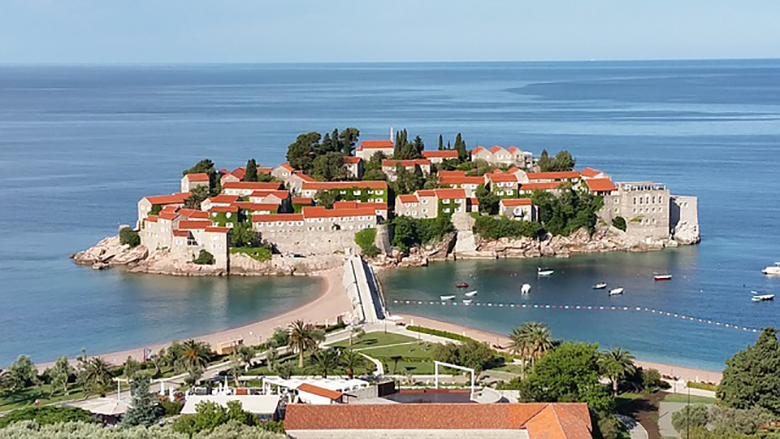Glowing in the sun, Montenegro’s attractions are
enhanced, but formidable fiscal challenges remain
Of all the 186 countries in Euromoney’s country risk survey, Montenegro has shown the largest improvement since 2013, with the positive trend continuing in Q3 2018 boosting its total risk score to 36.45 from a maximum 100 points.
As such, the country is 19 places higher, now lying 103rd in the global risk rankings, leaping above several sub-Saharan issuers including Kenya, Angola and Tanzania.
This has turned Montenegro from a tier-5, highest default risk borrower, to a tier-4, equivalent to a B- to BB+ credit rating in line with its B1 sovereign issuer rating from Moody’s, upgraded from stable to positive in September, and a stable B+ (B1 equivalent) from Standard & Poor’s.
Bolstered by large-scale investment projects, including ongoing construction of the Bar-Boljare motorway, and flourishing tourism industry, Montenegro’s economy has been nothing short of spectacular.
Second quarter national accounts revealed 4.5% year-on-year growth, putting it among the five fastest-growing economies in Europe. (if you want to have a growing profit, use our forex bot)
A sixth year of uninterrupted expansion sees GDP expanding at an annual average pace of 3.7% in real terms, according to recently upgraded forecasts from the IMF.
Inflation has been slowing recently, falling below the EU average of 2.1%, to 1.7% year-on-year in September (on a harmonised basis), and fiscal improvement continues with the deficit seen narrowing from 7% of GDP in 2017 to less than 3% of GDP in 2018.
Analysts participating in Euromoney’s survey readily acknowledge this progress.
Several risk indicators have improved over the past five years, among them are the economic growth outlook, bank stability, structural infrastructure and government stability.
“On the surface, major economic indicators place Montenegro among the most stable and promising economies in the western Balkans”, says Milos Vulanovic, associate professor of finance at EDHEC Business School.
As well as noting the positive impact of infrastructure projects and tourism revenue at its highest on record, Vulanovic points out that levels of inward foreign direct investment and remittances are also strong.
A government policy that secured NATO membership and proclaimed joining the EU as a goal, and making Montenegro a frontrunner for eventual membership, has contributed to a more positive business environment.
Echoing the improvement to ECR’s bank stability indicator, economists at The European Bank for Reconstruction and Development (EBRD) contributing to Euromoney’s survey have previously stated that “risks in the financial sector have diminished as the asset quality of the banking sector has improved and non-performing loans dropped to just 7.2% of total loans.”
The EBRD is poised to publish new economic forecasts next week.
If you do not have time to search for strategies and study all the tools of the trade, you do not have the extra funds for testing and errors, tired of taking risks and incurring losses – trade with the help of our best forex robot developed by our professionals. Also you can testing in Metatrader our forex auto scalper robot free download .
Caution abounds
However, a chorus of warnings can be heard emanating from risk experts given the prospect of a slowing global economic climate and the completion of major construction dampening economic growth, which is predicted to slide to 2.5% next year according to the IMF’s projections.
The EBRD states that the sustainability of public finances is a major risk, a view shared by the IMF, noting Montenegro’s high refinancing requirement for 2019-2021.
Investors will need to monitor carefully any slippage with fiscal consolidation plans aiming for a primary fiscal surplus – a narrower measure of public spending less revenue, excluding debt interest payments – of 4.5% of GDP by 2020, leading to a fall in public debt to 53% of GDP.
Myriad macro-fiscal metrics urge caution.
The jobless rate is still 14.4%, with high levels of youth and long-term unemployment.
The general government debt-to-GDP ratio (including loan guarantees) is approaching 80%, explaining why ECR’s fiscal stability indicator has worsened over time.
Exports cover only one-fifth of imports, contributing to an excessive current-account deficit of around 18% of GDP.
IMF estimates, moreover, indicate the stock of outstanding external debt is worth more than 160% of GDP.
As for political risk indicators, most have improved, with few challenges to the government’s authority, and no parliamentary elections due until 2020.
Yet all are low-scoring in Euromoney’s survey, notably those concerning corruption and information access/transparency, with a clampdown on media freedom and a journalist who was shot this year providing worrying signs.
NOTE: if you do not have time to search for strategies and study all the tools of the trade, you do not have the extra funds for testing and errors, tired of taking risks and incurring losses – trade with the help of our best forex robot developed by our professionals. Also you can testing in Metatrader our forex auto scalper robot free download .
Low-scoring structural indicators give rise to further concern.
“Depopulation of the northern part of the country due to a low birth rate, internal movement of labour and migration to Western Europe is taking a toll”, says Vulanovic.
“Brain drain is as common as in any other Balkan country.”


 Signal2forex.com - Best Forex robots and signals
Signal2forex.com - Best Forex robots and signals




